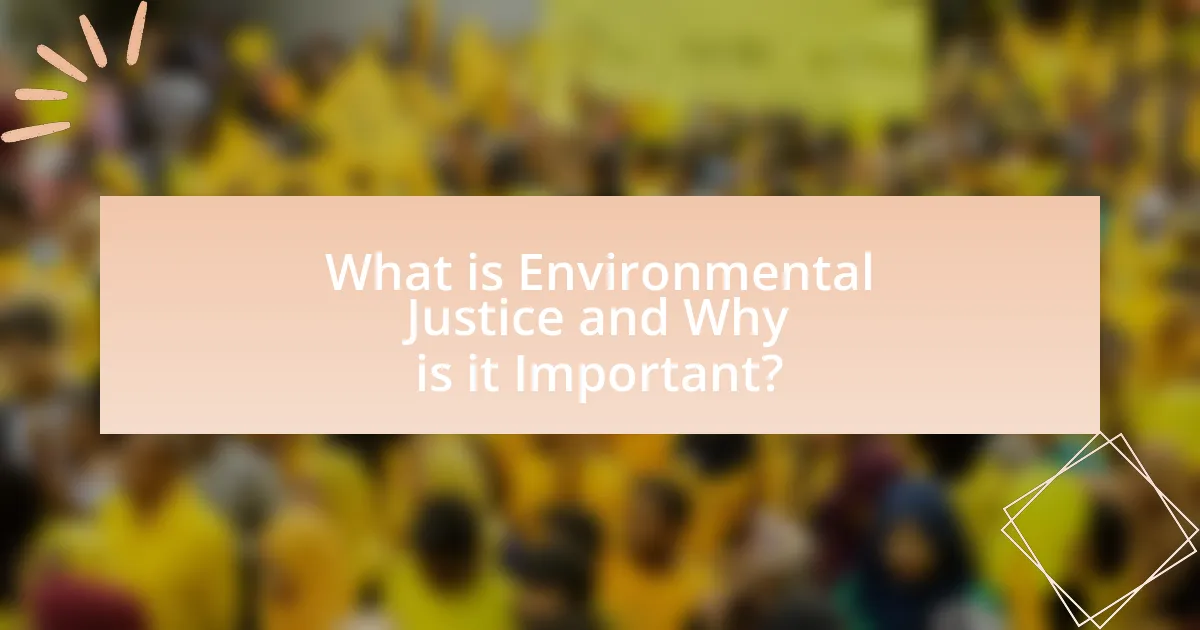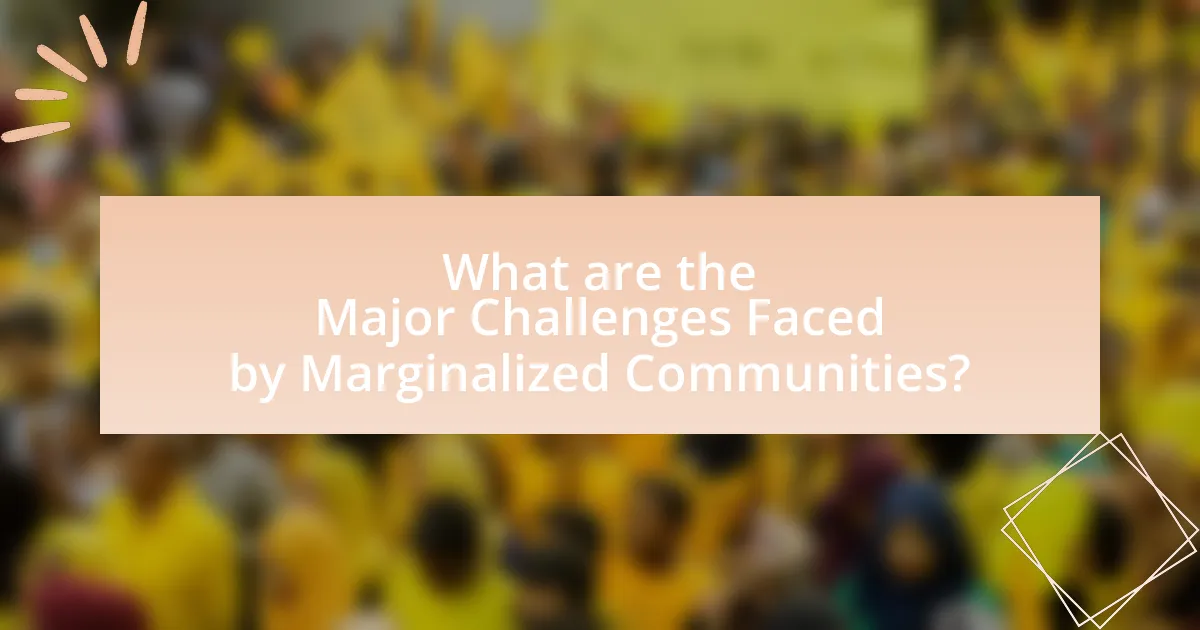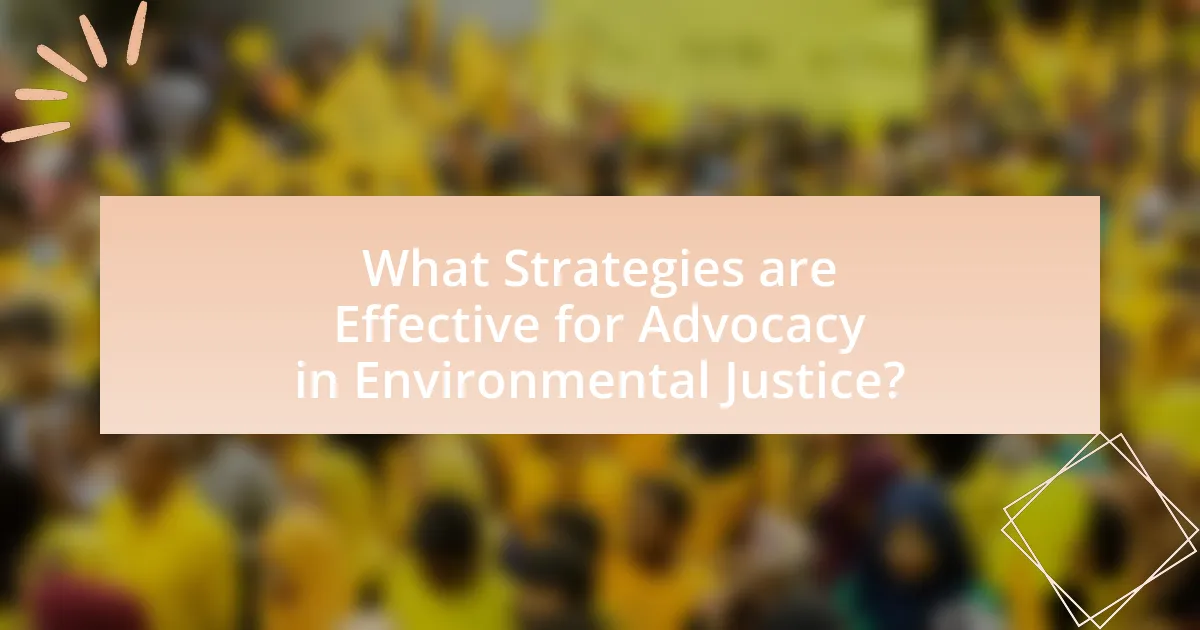Environmental justice is defined as the equitable distribution of environmental benefits and burdens, particularly focusing on the disproportionate impact of environmental hazards on marginalized communities. This article explores the significance of environmental justice, its historical roots, and the systemic inequalities that affect policy implementation. It highlights the challenges faced by low-income and minority populations, the principles guiding environmental justice advocacy, and effective strategies for community mobilization and policy change. Additionally, it discusses the role of legislation, technology, and partnerships in promoting environmental justice, emphasizing the need for inclusive decision-making processes that empower vulnerable communities.

What is Environmental Justice and Why is it Important?
Environmental justice is the equitable distribution of environmental benefits and burdens, ensuring that marginalized communities are not disproportionately affected by environmental hazards. It is important because it addresses systemic inequalities that lead to health disparities, economic disadvantages, and social injustices faced by these communities. For instance, studies show that low-income and minority populations are more likely to live near toxic waste sites, which can lead to higher rates of illness and lower quality of life. By advocating for environmental justice, society aims to create fair policies that protect vulnerable populations and promote sustainable development.
How does Environmental Justice relate to marginalized communities?
Environmental Justice directly addresses the inequities faced by marginalized communities in relation to environmental policies and practices. Marginalized communities often experience disproportionate exposure to environmental hazards, such as pollution and toxic waste, due to systemic inequalities in land use and resource allocation. For instance, studies show that low-income neighborhoods and communities of color are more likely to be situated near industrial sites, leading to higher rates of health issues like asthma and cancer. This correlation highlights the need for Environmental Justice initiatives that advocate for equitable treatment and protection of these communities, ensuring their voices are heard in decision-making processes regarding environmental regulations and resource management.
What are the key principles of Environmental Justice?
The key principles of Environmental Justice include the fair treatment and meaningful involvement of all people, regardless of race, color, national origin, or income, in environmental decision-making processes. This principle emphasizes that no group should bear a disproportionate share of negative environmental consequences resulting from industrial, governmental, and commercial operations. Additionally, Environmental Justice advocates for the right to a healthy environment, ensuring that marginalized communities have access to clean air, water, and land. The principles also stress the importance of community empowerment and the need for policies that address historical injustices and systemic inequalities in environmental governance.
How does systemic inequality impact environmental policies?
Systemic inequality significantly impacts environmental policies by perpetuating disparities in resource allocation and decision-making processes. Marginalized communities often face disproportionate environmental burdens, such as pollution and lack of access to clean resources, due to policies that prioritize the interests of more affluent populations. For instance, studies show that low-income neighborhoods and communities of color are more likely to be located near hazardous waste sites, as evidenced by the U.S. Environmental Protection Agency’s findings that these areas experience higher levels of toxic exposure. This inequitable distribution of environmental risks leads to health disparities and undermines the ability of these communities to advocate for their rights and needs in environmental policy discussions.
What are the historical roots of Environmental Justice?
The historical roots of Environmental Justice can be traced back to the civil rights movement of the 1960s, where marginalized communities began to advocate against environmental hazards disproportionately affecting them. This movement gained momentum with the 1982 protests in Warren County, North Carolina, against the siting of a hazardous waste landfill in a predominantly African American community, highlighting systemic inequities in environmental policy. The 1991 First National People of Color Environmental Leadership Summit further solidified the principles of Environmental Justice, emphasizing the need for equitable treatment and meaningful involvement of all people in environmental decision-making processes. These events collectively laid the groundwork for the formal recognition of Environmental Justice as a critical framework for addressing environmental inequalities.
How did the Environmental Justice movement begin?
The Environmental Justice movement began in the 1980s as a response to the disproportionate environmental burdens faced by marginalized communities, particularly communities of color. The movement gained momentum after the 1982 protests against a hazardous waste landfill in Warren County, North Carolina, which highlighted the systemic inequities in environmental policy and land use. This event catalyzed a broader awareness and activism around the intersection of environmental issues and social justice, leading to the establishment of key organizations and initiatives aimed at addressing these disparities.
What significant events have shaped the Environmental Justice landscape?
Significant events that have shaped the Environmental Justice landscape include the 1982 protests in Warren County, North Carolina, against a hazardous waste landfill, which marked a pivotal moment in the environmental justice movement. This event highlighted the disproportionate siting of toxic waste facilities in communities of color and led to increased awareness and activism regarding environmental racism. Additionally, the 1991 First National People of Color Environmental Leadership Summit established key principles of environmental justice, emphasizing the need for equitable treatment and involvement of marginalized communities in environmental decision-making. The 2005 Hurricane Katrina disaster further underscored systemic inequalities, as marginalized populations faced the brunt of environmental impacts and inadequate disaster response. These events collectively catalyzed policy changes and fostered a broader understanding of the intersection between environmental issues and social justice.

What are the Major Challenges Faced by Marginalized Communities?
Marginalized communities face significant challenges, including systemic inequality, limited access to resources, and environmental hazards. Systemic inequality manifests in discriminatory practices that restrict opportunities in education, employment, and healthcare, leading to socioeconomic disparities. Limited access to resources, such as clean water, nutritious food, and safe housing, exacerbates health issues and diminishes quality of life. Environmental hazards disproportionately affect these communities, as they are often located near polluting industries, leading to higher rates of respiratory diseases and other health problems. According to the Environmental Protection Agency, low-income and minority populations are more likely to live in areas with high levels of pollution, highlighting the urgent need for environmental justice initiatives to address these inequities.
How do environmental hazards disproportionately affect these communities?
Environmental hazards disproportionately affect marginalized communities by exposing them to higher levels of pollution and environmental risks due to systemic inequalities. These communities often reside in areas with greater industrial activity, leading to increased exposure to toxic substances, as evidenced by studies showing that low-income neighborhoods and communities of color are more likely to be located near hazardous waste sites. For instance, the U.S. Environmental Protection Agency reports that people of color are 1.5 times more likely to live in areas with high pollution levels compared to white populations. This unequal distribution of environmental hazards results in significant health disparities, including higher rates of respiratory diseases and other health issues among these populations.
What types of environmental hazards are most prevalent?
The most prevalent types of environmental hazards include air pollution, water contamination, hazardous waste, and climate change. Air pollution, primarily from industrial emissions and vehicle exhaust, significantly impacts public health, contributing to respiratory diseases and premature deaths. Water contamination often arises from agricultural runoff, industrial discharges, and inadequate waste management, leading to serious health risks such as gastrointestinal illnesses and long-term exposure effects. Hazardous waste, including chemicals and heavy metals, poses risks to both human health and ecosystems, particularly in marginalized communities where disposal practices may be less regulated. Climate change exacerbates these hazards by increasing the frequency and severity of extreme weather events, which disproportionately affect vulnerable populations. According to the World Health Organization, air pollution alone causes approximately 7 million premature deaths annually, highlighting the urgent need for environmental justice initiatives to address these disparities.
How do socioeconomic factors exacerbate these challenges?
Socioeconomic factors exacerbate challenges in environmental justice by limiting access to resources and opportunities for marginalized communities. Individuals in lower socioeconomic brackets often face inadequate housing, poor health care, and limited educational opportunities, which compound their vulnerability to environmental hazards. For instance, studies show that low-income neighborhoods are more likely to be situated near polluting industries, leading to higher exposure to toxic substances. According to the Environmental Protection Agency, communities of color and low-income populations are disproportionately affected by air pollution, which contributes to health disparities such as asthma and cardiovascular diseases. This systemic inequity highlights how socioeconomic status directly influences the ability of communities to advocate for their environmental rights and access necessary support.
What role does policy play in Environmental Justice?
Policy plays a crucial role in Environmental Justice by establishing frameworks that address inequities in environmental protection and resource distribution. Effective policies can mitigate the disproportionate impacts of environmental hazards on marginalized communities, ensuring equitable access to clean air, water, and land. For instance, the Environmental Protection Agency’s (EPA) Title VI of the Civil Rights Act prohibits discrimination in programs receiving federal assistance, thereby empowering communities to challenge harmful practices. Additionally, policies like the Justice40 Initiative aim to direct 40% of federal investments in climate and clean energy to disadvantaged communities, reinforcing the commitment to rectify historical injustices. These policy measures are essential for promoting fairness and accountability in environmental governance.
How can legislation support marginalized communities?
Legislation can support marginalized communities by enacting laws that ensure equitable access to resources, protection from discrimination, and the right to participate in decision-making processes. For instance, the Civil Rights Act of 1964 prohibits discrimination based on race, color, religion, sex, or national origin, which has historically empowered marginalized groups to seek justice and equality. Additionally, environmental laws like the National Environmental Policy Act (NEPA) require federal agencies to assess the environmental impacts of their actions, thereby giving marginalized communities a voice in environmental decision-making that affects their health and livelihoods. These legislative measures create frameworks that promote social equity and protect the rights of marginalized populations, ultimately fostering a more just society.
What are the barriers to effective policy implementation?
Barriers to effective policy implementation in the context of environmental justice include lack of funding, insufficient stakeholder engagement, and inadequate data collection. Lack of funding restricts resources necessary for executing policies, as evidenced by the Environmental Protection Agency’s report indicating that many local governments struggle to finance environmental initiatives. Insufficient stakeholder engagement leads to policies that do not reflect the needs of marginalized communities, which can result in resistance and non-compliance. Additionally, inadequate data collection hampers the ability to assess the impact of policies, making it difficult to adjust strategies effectively. These barriers collectively undermine the success of policies aimed at promoting environmental justice.

What Strategies are Effective for Advocacy in Environmental Justice?
Effective strategies for advocacy in environmental justice include community organizing, policy advocacy, and coalition building. Community organizing empowers marginalized groups by mobilizing them to address local environmental issues, as seen in the work of organizations like the Environmental Justice Alliance, which has successfully engaged communities in decision-making processes. Policy advocacy involves influencing legislation and regulations to protect vulnerable populations, exemplified by the successful passage of the Environmental Justice for All Act, which aims to address systemic inequities. Coalition building fosters collaboration among diverse stakeholders, enhancing the collective impact of advocacy efforts, as demonstrated by the collaboration between environmental groups and social justice organizations during campaigns like the Green New Deal. These strategies are effective because they leverage grassroots participation, promote equitable policy changes, and unite various interests to amplify the voices of marginalized communities.
How can communities mobilize for Environmental Justice?
Communities can mobilize for Environmental Justice by organizing grassroots campaigns that raise awareness about environmental issues affecting marginalized populations. These campaigns often involve community meetings, educational workshops, and partnerships with local organizations to identify specific environmental injustices, such as pollution or lack of access to clean water. For instance, the Environmental Protection Agency (EPA) has documented that low-income and minority communities are disproportionately affected by hazardous waste sites, highlighting the need for targeted advocacy. By leveraging data and community testimonies, these mobilization efforts can effectively pressure local governments and industries to implement equitable environmental policies.
What are successful case studies of community advocacy?
Successful case studies of community advocacy include the fight against the Dakota Access Pipeline and the efforts of the Flint water crisis activists. In the Dakota Access Pipeline case, the Standing Rock Sioux Tribe and their allies successfully mobilized public support and legal challenges, leading to a temporary halt of the pipeline construction in 2016. This advocacy highlighted issues of indigenous rights and environmental protection, drawing national attention and support. In Flint, Michigan, community activists raised awareness about lead contamination in drinking water, leading to significant policy changes and increased funding for infrastructure improvements. These cases demonstrate the power of grassroots organizing and community engagement in achieving environmental justice and advocating for marginalized communities.
How can grassroots organizations influence policy change?
Grassroots organizations can influence policy change by mobilizing community members to advocate for specific issues, thereby amplifying the voices of marginalized communities. These organizations often engage in activities such as organizing protests, conducting awareness campaigns, and lobbying policymakers to highlight the needs and concerns of the communities they represent. For instance, the Sierra Club’s grassroots campaigns have successfully led to the implementation of environmental policies that prioritize the health and well-being of low-income neighborhoods. Additionally, research indicates that grassroots movements can effectively sway public opinion, which in turn pressures legislators to enact favorable policies.
What tools and resources are available for advocates?
Advocates for environmental justice have access to various tools and resources that enhance their efforts. These include legal frameworks such as the National Environmental Policy Act (NEPA), which provides a basis for challenging harmful projects, and community organizing platforms that facilitate grassroots mobilization. Additionally, organizations like the Environmental Defense Fund and the Sierra Club offer training, funding opportunities, and research materials to support advocacy initiatives. Research studies, such as those published by the Journal of Environmental Management, provide data and case studies that inform strategies and highlight successful advocacy efforts. These resources collectively empower advocates to effectively address environmental injustices faced by marginalized communities.
How can technology aid in Environmental Justice efforts?
Technology can aid in Environmental Justice efforts by providing tools for data collection, analysis, and community engagement. For instance, geographic information systems (GIS) enable the mapping of environmental hazards in marginalized communities, allowing for targeted advocacy and policy interventions. Additionally, mobile applications facilitate real-time reporting of environmental issues, empowering residents to document and address local concerns. Research indicates that communities utilizing technology for environmental monitoring have successfully influenced policy changes, demonstrating the effectiveness of these tools in promoting equity and justice.
What role do partnerships play in advocacy initiatives?
Partnerships play a crucial role in advocacy initiatives by enhancing resource sharing, amplifying voices, and increasing the overall impact of campaigns. Collaborative efforts among various stakeholders, such as non-profits, community organizations, and governmental bodies, enable the pooling of expertise and resources, which is essential for addressing complex issues like environmental justice. For instance, the collaboration between the Sierra Club and local grassroots organizations has successfully mobilized communities to advocate for cleaner air and water policies, demonstrating how partnerships can lead to tangible policy changes. This synergy not only strengthens advocacy efforts but also fosters a more inclusive approach, ensuring that marginalized communities are represented and their needs addressed effectively.
What are the best practices for promoting Environmental Justice?
The best practices for promoting Environmental Justice include engaging marginalized communities in decision-making processes, ensuring equitable access to environmental resources, and implementing policies that address systemic inequalities. Engaging communities allows for the identification of specific local issues and fosters trust, as seen in successful initiatives like the EPA’s Environmental Justice Collaborative Problem-Solving Model, which emphasizes community involvement. Ensuring equitable access involves creating policies that prioritize the needs of disadvantaged groups, such as the Clean Power Plan, which aimed to reduce pollution in low-income areas. Addressing systemic inequalities requires comprehensive assessments of environmental impacts on vulnerable populations, supported by data from studies like the 2018 report by the National Academies of Sciences, Engineering, and Medicine, which highlighted the disproportionate effects of environmental hazards on marginalized communities.
How can individuals contribute to Environmental Justice efforts?
Individuals can contribute to Environmental Justice efforts by actively participating in community advocacy, supporting policies that promote equitable environmental protections, and educating themselves and others about environmental issues affecting marginalized communities. Engaging in local organizations focused on environmental justice, such as attending meetings or volunteering, helps amplify the voices of those disproportionately impacted by environmental hazards. Research indicates that grassroots movements have successfully influenced policy changes, demonstrating the power of collective action in addressing systemic inequalities. For example, the Environmental Justice Movement has led to significant legislative advancements, such as the establishment of the Environmental Protection Agency’s Office of Environmental Justice in 1994, which aims to address the needs of vulnerable populations.
What strategies can organizations adopt to enhance their impact?
Organizations can enhance their impact by implementing community engagement strategies that prioritize the voices and needs of marginalized communities. By actively involving these communities in decision-making processes, organizations can ensure that their initiatives are relevant and effective. Research shows that when organizations collaborate with local stakeholders, they achieve better outcomes; for instance, a study by the National Environmental Justice Advisory Council found that community-driven projects lead to a 30% increase in project success rates. Additionally, organizations can adopt data-driven approaches to assess the specific needs of these communities, allowing for targeted interventions that address unique challenges. This combination of community engagement and data utilization not only amplifies the voices of marginalized groups but also fosters trust and collaboration, ultimately enhancing the overall impact of the organization’s efforts in promoting environmental justice.